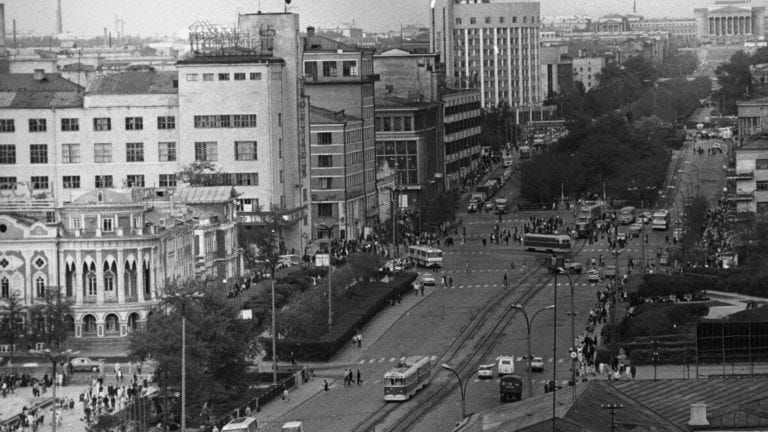Correcting The Congressional Testimony of Dr. David Morens
Regarding the Accident Which Led to the Outbreak of Anthrax in Sverdlovsk, USSR in June 1979
The following statement is written by Milton Leitenberg, a senior research associate at the Center for International and Security Studies at the University of Maryland (CISSM).

On January 18, 2024 Dr. David Morens testified before the COMMITTEE ON OVERSIGHT AND ACCOUNTABILITY, SELECT SUBCOMMITTEE ON THE CORONAVIRUS PANDEMIC of the U.S. HOUSE OF REPRESENTATIVES.
Dr. David Morens had previously served as a Senior Advisor to Dr. Anthony Fauci, Director of the National Institute of Allergy and Infectious Diseases, NIAID. The following exchange took place between a committee Counsel and Dr. Morens during a discussion of laboratory accidents:
Dr. Morens: But, lab accidents that occur in the lab and harm somebody, there's a number of them. And the Sverdlovsk anthrax outbreak was not, strictly speaking, a lab accident, it was an explosion. And the people who got killed were downstream of the anthrax spores, it wasn't a lab-related thing.
Q. The lab exploded?
A. the lab exploded.
Q. It wouldn't have been released but for the lab explosion?
A. That's right.
Both Dr. Morens and the Committee counsel who accepted his word were mistaken, and in 2024 they certainly should not have been.
The lab did not explode. There was no “explosion.”
Sverdlovsk, the city in which the accident took place, was a closed city in the Soviet era, and the facility in which the accident occurred was commonly referred to as “Compound 19.” More formally it was the Military Technical Scientific Research Institute, one of the four major facilities of the offensive biological weapons program of the Soviet Ministry of Defense. Its role was to produce dry powder Bacillus anthracis in ton quantities.
The accident at Compound 19 took place on April 2, 1979. Among the very first reports that were published in the West after the accident and the outbreak of anthrax in the city began, was one published in an emigre Russian publication in West Germany that spoke of an “explosion” at the facility. This was repeated in some early reports that appeared in the U.S., and one Russian author persisted in attributing the accident to an “explosion” long after it was known not to be correct. However, once an authoritative report of what happened became available in 1999, it has been universally accepted that there was no explosion. Milled and dried anthracis spores escaped from Compound 19 because of an accident of another kind.
Anthracis production at Compound 19 worked in shifts, 24 hours per day. As any such facility must, Compound 19 had an air handling system which filtered the air leaving the plant, and moreover the facility was located within the city limits. The Soviets used an accordion-like filter located in the exhaust ducts to filter particles out of the plant air before the air was expelled to the outside. At the end of one shift a clogged filter was removed, which was a routine occurrence. According to the narrative of the shift supervisor, Lt. Col Nikolai Chernyshev, a new filter was not emplaced directly, but a note was left for the next shift supervisor to do that.
The note was overlooked and the next shift switched on the dryers and milled dry powder anthracis spores escaped from the plant through the air vents. After some time the accident was noticed and a new filter was installed, but in the interval a sufficient quantity of spores had escaped from Compound 19 to be lethal four kilometers downwind. Officially 66 people died, but it is suspected that the actual number is higher, perhaps around 100.
Dr. Morens’ statement that the release of anthracis spores from Compound 19 in Sverdlovsk “-- wasn't a lab-related thing” is of course nonsense. Human error of whatever kind in a laboratory or related facility handling pathogens qualifies as “an accident.” More importantly, in addition to the error per se, any broader implications that Dr. Morens drew from his false claim are therefore invalidated.
The sources for the above are:
1. Milton Leitenberg, “A Return to Sverdlovsk: Allegations of Soviet Activities Related to Biological Weapons,” Arms Control, vol 12, no 2, September 1991, pp. 161-190.
2. Milton Leitenberg, “Anthrax in Sverdlovsk: New Pieces of the Puzzle,” Arms Control Today, vol 22, no 3, April 1992, pp. 10-13.
3. Mathew M. Meselson et al., "The Sverdlovsk Anthrax Outbreak of 1979", Science, 266 [1994]; 1202-1208
4. Ken Alibek with Stephen Handelman, Biohazard, Random House, New York, 1999, pgs.72-76
5. Milton Leitenberg and Raymond Zilinskas, The Soviet Biological Weapon Program, a History, Harvard University Press, Cambridge, Massachusetts, 2012, pgs. 103-112 and 423-429





